How to use the matching function in office
How to use office matching function
1. Matching keywords--that is, assuming that cell F1 is the matching keyword, enter F1
2. Matching area--to put it simply, you need to find the area that contains the keywords that need to be matched, such as A1:E100
When specifying column extraction, if you need to extract the data in column C from column A where the matching content is located in the area A1:E100, you need to enter the number 3.
4. Exact or fuzzy matching, generally fill in the number 0
for example:
=VLOOKUP(F1,$A$1:$E$100,3,0)
means:
Look for the cell content of F1. Compared with F1, this cell corresponds to the area A1:E100, and extract the content of the cell in column C.
Generally, this function is used to input a number and extract the corresponding content representing this number. For example, if you enter a product number, you can extract the unit price, quantity, and production date of the product number one by one.
How to use VLOOKUP to match data in excel table
In its simplest form, the VLOOKUP function means:
=VLOOKUP (value to look for, range to look for value in, column number in range containing return value, exact match or approximate match – specified as 0/FALSE or 1/TRUE).

Detailed explanation of parameters and key points:
1. The value to be found is also called the lookup value. That is to say, who should be checked according to whom? In the above example it is the "Fund Code".
2. Check the area where the value is located. Remember that the lookup value should always be in the first column of the range for VLOOKUP to work properly. In the above example, it is the area C2:D7.
3. The column number in the area contains the return value. In the above example, the value to be returned is in column D, so C is 1 and D is 2.
(Optional) If an approximate match of the return value is required, you can specify TRUE; if an exact match of the return value is required, specify FALSE. If nothing is specified, the default value will always be TRUE or an approximate match.
How to match the vlookup function in excel
Format:
=VLOOKUP(parameter1,parameter2,parameter3,parameter4)
meaning:
"Parameter 1" is the value that needs to be found in the first column of the array, which can be a numerical value, a reference or a text string; "Parameter 2" is the data table in which the data needs to be found; "Parameter 3" is "Parameter 2" is the column number of the matching value to be returned; "Parameter 4" is a logical value that indicates whether VLOOKUP returns an exact match or an approximate match.
illustrate:
"Parameter 1" is the search content; "Parameter 2" refers to the range of data search (cell area); "Parameter 3" refers to the value to be searched in "Parameter 2", which is the range of data search (cell area) The column number in the area), "Parameter 3" is "2", that is, the value is in the 2nd column. "Parameter 4" is 0 for exact search (can be omitted when it is FALSE).
For example,
"VLOOKUP($F$28,$A$7:$B$1500,2,0)" means to find the row equal to F28 in column A in the range of $A$7:$B$1500 and return to column 2 ( Column B), the last 0 represents exact search;
"VLOOKUP(F28,$A$7:$J$1500,3,0)" means to find the row equal to F28 in column A in the range of $A$7:$J$1500, and return to column 3 (column C ), the last 0 represents exact search.
How Excel automatically matches data
For data returned through multi-condition query matching, it can be achieved through the INDEX MATCH array formula.
The specific operation method is:
1. Open the worksheet of Excel 2007 or above;
2. Enter the following array formula in the target cell, press the Ctrl Shift Enter key combination to end, and then fill in the formula from the right to the bottom
=INDEX(C:C,MATCH($F3&$G3,$A:$A&$B:$B,0))
Formula expression: locate column C and return the data of the row corresponding to the condition that F3 and G3 exist in column A and column B at the same time.

3. When the data area cannot meet the query conditions, an error value #N/A;
will be returned.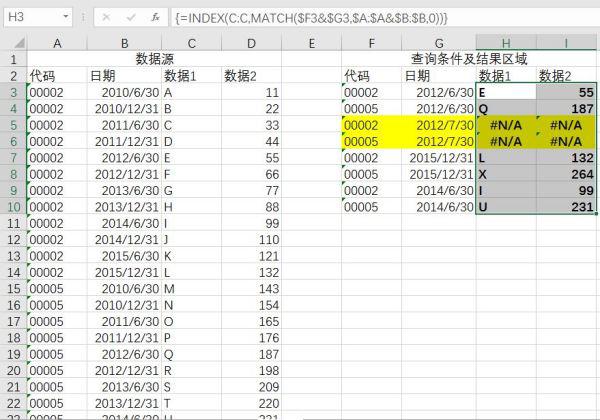
4. You can add the IFERROR function to return the error value as customized content, such as spaces or "does not exist"
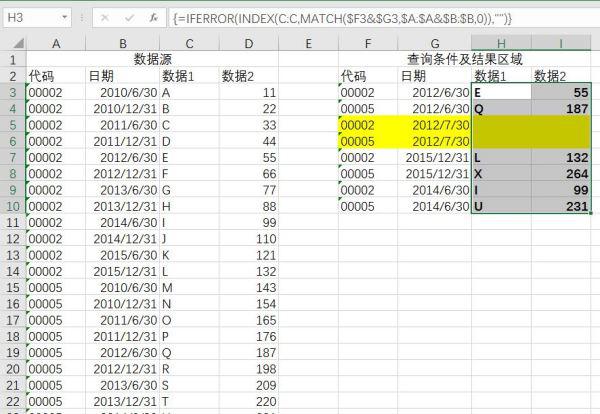
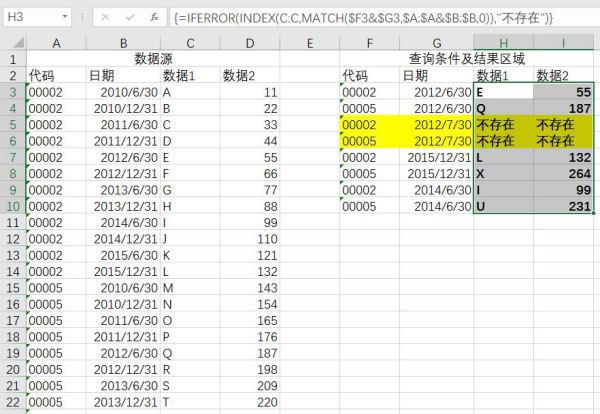
5. If you are using Excel 2003, because Excel 2003 does not support the entire column reference, you need to modify the entire column in the formula to a specific data area. Pay attention to adding the absolute reference symbol $ to avoid referencing when the formula is filled downwards and to the right. The area changes.
The formula is modified to: =INDEX(C$2:C$26,MATCH($F3&$G3,$A$2:$A$26&$B$2:$B$26,0))

6. If you are using Excel 2003, when the data area cannot meet the query conditions, an error value #N/A;
will be returned.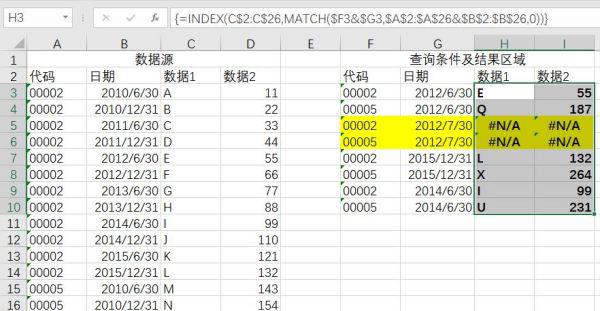
7. Excel 2003 does not support the IFERROR function. You can use the IF ISERROR function instead, and change the formula to
=IF(ISERROR(INDEX(C$2:C$26,MATCH($F3&$G3,$A$2:$A$26&$B$2:$B$26,0))),"",INDEX(C $2:C$26,MATCH($F3&$G3,$A$2:$A$26&$B$2:$B$26,0)))
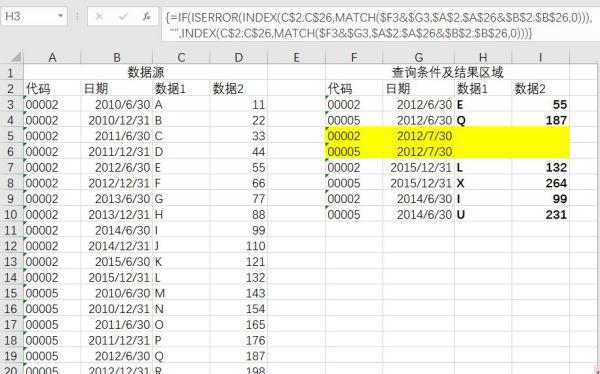
Note: The formulas involved in this column are all array formulas, and you need to press the Ctrl Shift Enter key combination to end, otherwise the error value #N/A will be returned.
The above is the detailed content of How to use the matching function in office. For more information, please follow other related articles on the PHP Chinese website!

Hot AI Tools

Undresser.AI Undress
AI-powered app for creating realistic nude photos

AI Clothes Remover
Online AI tool for removing clothes from photos.

Undress AI Tool
Undress images for free

Clothoff.io
AI clothes remover

AI Hentai Generator
Generate AI Hentai for free.

Hot Article

Hot Tools

Notepad++7.3.1
Easy-to-use and free code editor

SublimeText3 Chinese version
Chinese version, very easy to use

Zend Studio 13.0.1
Powerful PHP integrated development environment

Dreamweaver CS6
Visual web development tools

SublimeText3 Mac version
God-level code editing software (SublimeText3)

Hot Topics
 Your Calculator App Can Be Replaced By Microsoft Excel
Mar 06, 2025 am 06:01 AM
Your Calculator App Can Be Replaced By Microsoft Excel
Mar 06, 2025 am 06:01 AM
Ditch the Calculator: Why and How to Use Excel for All Your Calculations I haven't touched a calculator in ages. Why? Because Microsoft Excel handles all my calculations with ease, and it can do the same for you. Why Excel Trumps a Calculator While
 Don't Create Tables in Word: Use Excel Instead
Mar 06, 2025 am 03:04 AM
Don't Create Tables in Word: Use Excel Instead
Mar 06, 2025 am 03:04 AM
Creating tables in Word, although improved, is still cumbersome and sometimes brings more problems. This is why you should always create tables in Microsoft Excel. Why is it better to create tables in Excel? In short, Word is a word processor, while Excel is a data processor. So Word is not built for the best table creation, but its similar product, Excel. Here are just some of the reasons why creating tables in Excel is better than using Microsoft Word: Although it is surprising that you can use many Excel-like features in Microsoft Word tables, in Excel you
 How to Reduce the Gaps Between Bars and Columns in Excel Charts (And Why You Should)
Mar 08, 2025 am 03:01 AM
How to Reduce the Gaps Between Bars and Columns in Excel Charts (And Why You Should)
Mar 08, 2025 am 03:01 AM
Enhance Your Excel Charts: Reducing Gaps Between Bars and Columns Presenting data visually in charts significantly improves spreadsheet readability. Excel excels at chart creation, but its extensive menus can obscure simple yet powerful features, suc
 5 Things You Can Do in Excel for the Web Today That You Couldn't 12 Months Ago
Mar 22, 2025 am 03:03 AM
5 Things You Can Do in Excel for the Web Today That You Couldn't 12 Months Ago
Mar 22, 2025 am 03:03 AM
Excel web version features enhancements to improve efficiency! While Excel desktop version is more powerful, the web version has also been significantly improved over the past year. This article will focus on five key improvements: Easily insert rows and columns: In Excel web, just hover over the row or column header and click the " " sign that appears to insert a new row or column. There is no need to use the confusing right-click menu "insert" function anymore. This method is faster, and newly inserted rows or columns inherit the format of adjacent cells. Export as CSV files: Excel now supports exporting worksheets as CSV files for easy data transfer and compatibility with other software. Click "File" > "Export"
 How to Use the AVERAGEIF and AVERAGEIFS Functions in Excel
Mar 07, 2025 am 06:03 AM
How to Use the AVERAGEIF and AVERAGEIFS Functions in Excel
Mar 07, 2025 am 06:03 AM
Quick View of AVERAGEIF and AVERAGEIFS Functions in Excel Excel's AVERAGEIF and AVERAGEIFS functions can be used to calculate the average value of a dataset. However, unlike simpler AVERAGE functions, they are able to include or exclude specific values in the calculation. How to use the AVERAGEIF function in Excel Excel's AVERAGEIF function allows you to calculate the average value of a filtered dataset based on a single condition set. AVERAGEIF function syntax The AVERAGEIF function contains three parameters: =AVERAGEIF(x,y,z)
 How to Use LAMBDA in Excel to Create Your Own Functions
Mar 21, 2025 am 03:08 AM
How to Use LAMBDA in Excel to Create Your Own Functions
Mar 21, 2025 am 03:08 AM
Excel's LAMBDA Functions: An easy guide to creating custom functions Before Excel introduced the LAMBDA function, creating a custom function requires VBA or macro. Now, with LAMBDA, you can easily implement it using the familiar Excel syntax. This guide will guide you step by step how to use the LAMBDA function. It is recommended that you read the parts of this guide in order, first understand the grammar and simple examples, and then learn practical applications. The LAMBDA function is available for Microsoft 365 (Windows and Mac), Excel 2024 (Windows and Mac), and Excel for the web. E
 Microsoft Excel Keyboard Shortcuts: Printable Cheat Sheet
Mar 14, 2025 am 12:06 AM
Microsoft Excel Keyboard Shortcuts: Printable Cheat Sheet
Mar 14, 2025 am 12:06 AM
Master Microsoft Excel with these essential keyboard shortcuts! This cheat sheet provides quick access to the most frequently used commands, saving you valuable time and effort. It covers essential key combinations, Paste Special functions, workboo
 If You Don't Use Excel's Hidden Camera Tool, You're Missing a Trick
Mar 25, 2025 am 02:48 AM
If You Don't Use Excel's Hidden Camera Tool, You're Missing a Trick
Mar 25, 2025 am 02:48 AM
Quick Links Why Use the Camera Tool?






